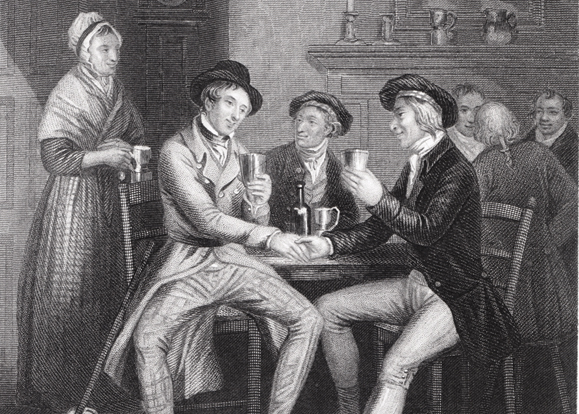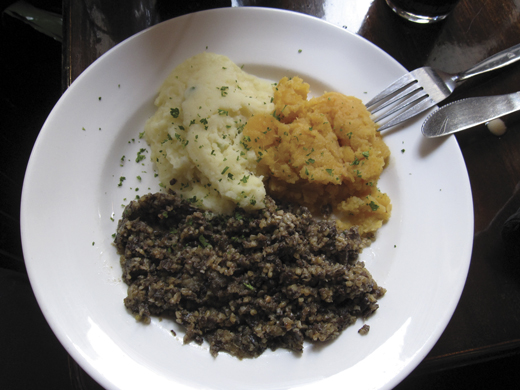With the New Year in mind, Edythe Preet writes about Robert Burns: Scotland’s Immortal Bard.
In case any reader has ever wondered how a gal named Preet could claim Irish ancestry, here’s my genealogy: my maiden name was Burns, my father was George Burns (mom heard many a “So are you Gracie?” wisecrack), and dad’s mom was a McCaffrey, born in County Fermanagh. Like thousands of Northern Ireland’s population, Margaret McCaffrey was a descendant of the Scots who immigrated to neighboring Éire during the 16th and 17th centuries.
While Dad was Irish to the core, he held one particular Scotsman in highest esteem: Robert Burns, Scotland’s Immortal Bard. Dad loved poetry, and he took great pleasure reciting his ancestor’s rhymes (especially the racy or politically barbed verses) with vigor and full brogue. So it is to the Scots-Irish among us that I dedicate this article.
Every New Year’s Eve, as the clock strikes 12, people the world over raise their glasses in a toast and their voices in song: “Lest auld acquaintance be forgot and never brought to mind … we’ll take a cup o’ kindness yet for auld lang syne.” Those heartfelt words, enjoining us to always remember and hold dear the good times and good friends we have known, were penned by Robert Burns.
Burns, the man, was a humble country farmer. Burns, the poet, was a romantic, a humorist, a philosopher, a champion of human rights, and a fervent patriot. Born January 25, 1756, he lived in a time of international political upheaval that witnessed the American, Irish, and French revolutions, which changed the course of history. His sentiments won the hearts of his countrymen and patriots everywhere, and his words are etched forever in the English language.
“A man’s a man for a’ that,” the phrase that has become a mantra of oppressed people the world over, is found in the allegorical epic “Tam O’Shanter.” “The best laid schemes o’ mice and men’’ appears in “To a Mouse,” and “To see ourselves as others see us” in “To a Louse” (which he was inspired to write one Sunday in church while watching one of the loathsome blood-suckers crawl about a fellow parishoner’s shoulders). The poem “Man Was Made To Mourn” addresses the injustice and inequality of the human condition, and “My Love Is Like a Red Red Rose” is the paragon ode to ardent and enduring love.
Throughout his life, Burns fought the force of the establishment with the power of poetry. Nothing, and no one, escaped the scathing satire and wry humor of his pen. At a time when speaking up was the surest and quickest route to exile and deportation, Burns boldly criticized the Crown, the Church and the entire legal profession. He wrote of justice, honor, love and freedom – the highest of human ideals. He articulated the grief of his disenfranchised nation and encouraged all people far and wide who would dream of higher aspirations.
From his deathbed, Burns whispered, “In a hundred years, they will remember me,” and indeed they have. On January 25 in bonny Scotland and wherever those of Caledonian descent are found, Burns Night Suppers honor the Bard in a way that would please him immensely – with food and drink and caustic verse aplenty.
The stars of the evening, other than Burns himself, are the haggis and malt whisky. Taken separately they are notably delicious, consumed together they are ambrosia fit for the gods. Though many food critics disparage the haggis as coarse peasant fare, this most quintessential of Gaelic dishes is truly a gourmet’s delight.
Admittedly, perusing haggis recipes can be somewhat off-putting because they call for minced offal (heart, tongue, liver and lung) to be mixed with oats, salt and pepper, then stuffed into sheep or cow tripe (stomach), trussed, closed and boiled for hours. Letting the description dissuade you from tasting it would be a classic case of judging a book by its cover. Indulging in a plateful of steaming, spicy, sliced haggis is one of life’s great taste treats, especially when said slices are liberally doused with a fine, aged, malt whisky.
How haggis came to be Scotland’s best-known menu item is a matter for conjecture. In prehistoric times, slices of meat could be smoked over an open fire and kept for later use without spoiling, but the humbles or innards spoiled quickly, and it was necessary to consume them as soon as possible.
Prior to the invention of pots and pans, the easiest way to cook bits and pieces of meat was to place them in the animal’s bag-like stomach and boil the whole affair in a water-filled pit heated with red-hot stones. Adding grain (in Scotland and Ireland, it was oats) allowed the nutrient-rich juices to be absorbed rather than dissipating into the cooking liquid.
By the late 18th century, Scotland had been joined with Ireland, Wales, and England to form the United Kingdom, and while haggis was still the most popular Scottish meal, many gentrified Scots were attempting to modify their national culture by adopting English pronunciation to fit into the new society. Burns lambasted the trend by writing “The Address to the Haggis,” a pointed social satire in a full, flaming Scots dialect. It was an instant hit. More than 200 years later, it is still recited in a broad brogue at every Burns Supper.
The night’s other star player is malt whisky. Arabia gets the credit for devising the alcohol-distillation process, which was subsequently discovered by monks traveling through the Middle East in the early days of Christianity. When the Church began sending missionaries to Ireland and Scotland in the sixth century, the pious prelates applied the same technique to a brew of the local grains – malt and barley – and invented malt whisky. Gaels took to the drink like ducks to water.
Should you choose to host a Burns Night Supper, be advised that there is a formula to the event. The evening festivities begin with a welcome, followed by recitation of the “Grace Before the Meal,” which Burns delivered when he supped with the Earl of Selkirk who shared the poet’s libertine political views. “Some hae meat and canna eat, And some wad eat that want it. But we hae meat and we can eat, And sae the Laird be thankit.”
The meal begins with a serving of cockaleekie soup, after which a steaming hot haggis is ceremoniously brought into the room to the wail of bagpipes. An honored guest then recites “The Address to the Haggis” and all toast his performance with glasses of whisky, after which the noble haggis is retired to be sliced and dished up with portions of its traditional accompaniments – neeps and tatties (mashed turnips and potatoes).
While waiting for dinner to be served, the evening’s honored guest speaks to the memory of the Immortal Bard, and more whisky is downed. Then a gentleman delivers “The Toast to the Lassies” (usually full of tongue-in-cheek wordplay) and more whisky is downed. Then a lady responds with “The Toast to the Laddies” (usually a wee bit bawdy) and more whisky is downed.
While dining on the haggis (over each serving of which is poured a healthy measure of whisky), guests take turns reciting their favorite Burns verses, and after each performance more whisky is downed. When the dishes have been cleared, it’s time for dancing to the tune of fiddles and bagpipes, and between each reel more whisky is downed.
When everyone is nigh unto swooning from the heady pace of the dance, all hoist their once-again full glasses of whisky in a final toast and raise their voices in song: “Lest auld acquaintance be forgot and never brought to mind, we’ll take a cup o’ kindness yet for auld lang syne.” Sláinte! ♦
℘℘℘
RECIPES
NOTE: Full information on staging a Burns Supper – including poems, toasts, and songs – can be found at www.milwburnsclub.org/bsupper.htm
Cockaleekie Soup
6 leeks, washed & sliced thin
3 cups boiling water
1 1⁄2 teaspoons salt
2 tablespoons butter
1 1⁄2 cups chicken broth
1⁄2 cup cream
Place the sliced leeks in a medium soup pot with the water and salt; simmer for 5-7 minutes until tender but not mushy. Add butter and chicken broth, bring to a boil. Stir in the cream. Makes 5-6 cups soup.
– Personal Recipe
℘℘℘
Mashed Neeps & Tatties
1 1⁄2 pound potatoes, peeled & quartered
1 1⁄2 pound turnips or rutabagas, peeled & quartered
Cream
Salt and pepper
In two separate pots, cover potatoes and turnips with water and boil until tender. Drain, combine, and mash, adding cream as needed. Season to taste with salt and pepper. Serves 6-8.
– The Robert Burns Club, Milwaukee
℘℘℘
Modern Haggis
1⁄2 pound calf’s liver
1⁄2 cup oatmeal
2 tablespoons shortening
1 medium onion
1⁄4 teaspoon cayenne pepper
1⁄4 teaspoon black pepper
1⁄2 teaspoon nutmeg
1⁄2 teaspoon mace
1⁄4 teaspoon salt
Boil the liver and parboil the onion. Reserve 1⁄2 cup of the stock. Mince the liver and onion together until the texture of coarse meal. Lightly brown the oatmeal and then mix all the ingredients together, along with the reserved stock. Place in a greased bowl. Cover with aluminum foil and place in a steamer. Steam for 11⁄2 hours. Serves 4-6 Haggis lovers, or 6-8 more dubious diners.
– The Robert Burns Club, Milwaukee



Few issues with this. First and foremost, ‘Scots Irish’ doesn’t mean you have Scottish and Irish heritage, it means you’re an ulster scot. Which brings me onto my second point, you claim the scots ‘immigrated’ to ulster in Ireland without a second word about it, as if it was peaceful and accepted. No, it was a bloody invasion, the Scots essentially committed ethnic cleansing against the native Irish, and the divide between the Scottish invaders and native Ireland can still be seen today with the fact ireland is split into two countries. Those descendents of Ulster Scots today refer to themselves as British. So there’s something ironic of someone who is descended from an invader of Ireland to pretend to be proud to be irish, because the actual ‘Scots irish’ still in Ireland today actively don’t refer to themselves as Irish, but British.
Jason speaks the truth.
Auld Lang Syne is Lowland Scottish, not Scottish “Gaelic”
There is only one Gaelic, it is Irish, and Auld Lang Syne sung in Irish is wonderful.
https://www.youtube.com/watch?v=ke5_Gok_Oao
So Scottish Gaelic doesn’t exist? On what planet?